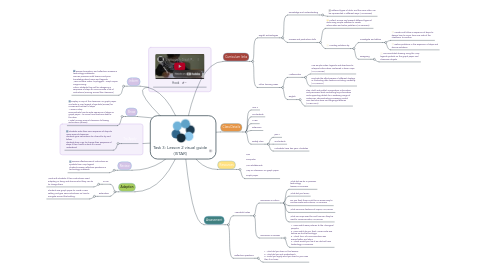
1. Hook
2. Inform
2.1. Review brainstorm and reflection answers in technology notebooks Discuss previous math lessons and prior knowledge about maps and legends View Youtube video ‘Unplugged - Graph Paper Programming’ Inform students they will be designing a sequence of steps to communicate a set of instructions (moving around the classroom)
3. Show
3.1. Display a map of the classroom on graph paper and write a map legend of symbols (arrows) for movement/number of steps 1 arrow=1step Demonstrate how to write sequence of steps on graph paper - to move from teacher’s desk to the door Model moving around classroom following instructions (arrows)
4. Try/Apply
4.1. Students write their own sequence of steps to move around classroom Students give instructions to a friend to try and follow Students have a go to change their sequence of steps if their friend is stuck or cannot understand
5. Review
5.1. Discuss effectiveness of instructions as symbols from map legend Students answer reflection questions in technology notebook
6. Adaption
6.1. EALD
6.1.1. Work with students if their instructions need adapting or fixing and discuss what they can do to change them
6.2. Extenstion
6.2.1. Students use graph paper to create a new setting and give new instructions on how to navigate around that setting.
7. Curriculum links
7.1. Digital Technologies
7.1.1. Knowledge and understanding
7.1.1.1. Different types of data, and the same data, can be represented in different ways (ACTDIK008)
7.1.2. Process and production skills
7.1.2.1. Collect, access and present different types of data using simple software to create information and solve problems (ACTDIP009)
7.1.2.2. Creating solutions by
7.1.2.2.1. Investigate and define
7.1.2.2.2. Designing
7.2. Other learning areas
7.2.1. Mathematics
7.2.1.1. Use simple scales, legends and directions to interpret information contained in basic maps (ACMMG090)
7.2.1.2. Evaluate the effectiveness of different displays in illustrating data features including variability (ACMSP097)
7.2.2. English
7.2.2.1. Plan, draft and publish imaginative, informative and persuasive texts containing key information and supporting details for a widening range of audiences, demonstrating increasing control over text structures and language features (ACELY1694)
8. Class Details
8.1. Year 4
8.2. 28 Students
8.3. SAER
8.4. Estension
8.5. Buddy class
8.5.1. year 1
8.5.2. 22 students
8.5.3. 6 students have two year 4 buddies
9. Assessment
9.1. Anecdotal notes
9.1.1. Discussion in Inform
9.1.1.1. What did we do in previous technology lesson?ACTDIP009
9.1.1.2. What did you learn?
9.1.1.3. Do you think there could be an easier way to communicate instructions? ACTDIP009
9.1.1.4. What are some features of maps? ACMSP097
9.1.1.5. What are maps used for and how can they be used to communicate? ACMSP097
9.1.2. Discussion in Review
9.1.2.1. 1. How useful were pictures to the Aboriginal people? 2. How useful do you think Morse code was before we had technology? 3. Which form of communication was easier/better and why? 4. Which would you use if we did not have technology.ACTDIP009
9.2. Reflection questions
9.2.1. 1. What did you learn in this lesson? 2. What did you not understand? 3. Could you apply what you leant in your own life? If so how?
